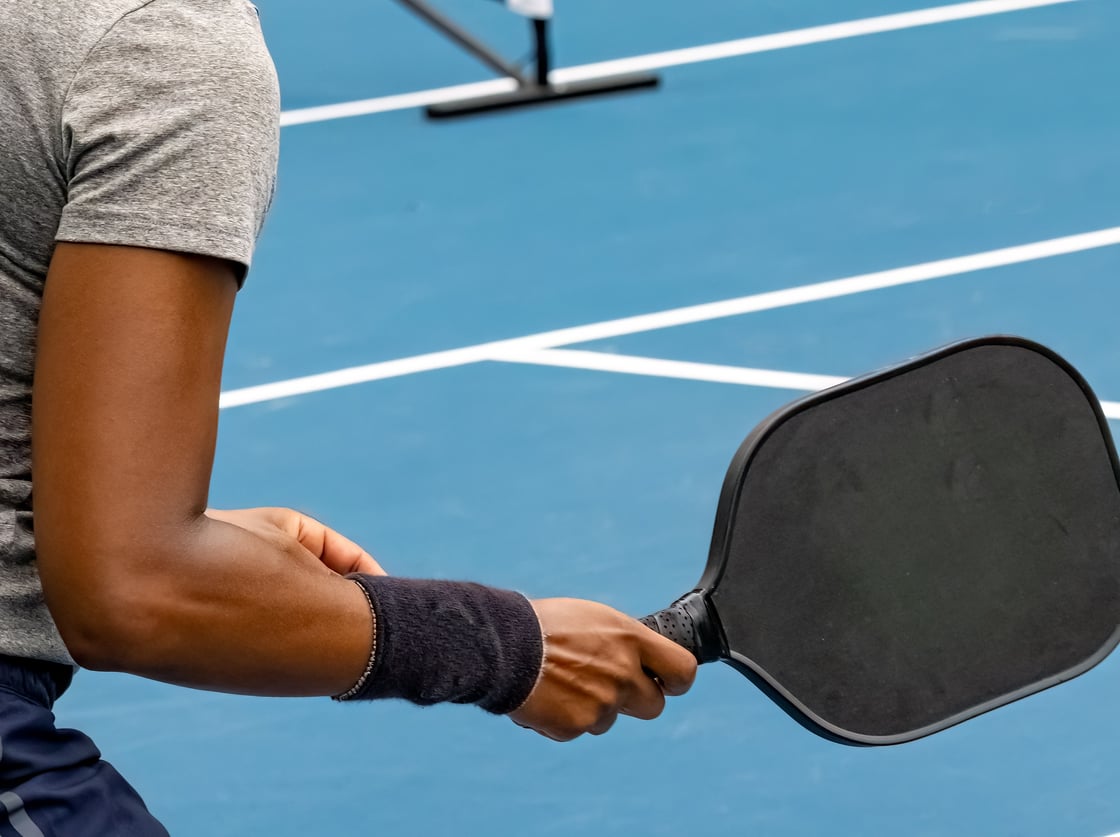Do you get caught with your paddle tipped in one direction or the other? Many players feel more confident playing their forehand or backhand. Yes, backhand can be favoured in pickleball.
I’m mostly referring to the backhand when playing through the transition zone or at the non-volley line, versus the baseline, though.
I often help students identify that their backhand can cover so much more “surface area” than the forehand, and this is why many people slightly cheat to the backhand side while in the ready position.
Cleaning up your ready position is a great way to be alert and stay engaged in the longer rallies and stop yourself being caught out.
What is the Ready Position?
This is a position you want to get into when you’re waiting for the opponent to hit their shot, preparing yourself to respond to what they do. A solid ready potion is an athletic stance, with the feet about shoulder-width apart.
It’s important to stand with the weight of the body balanced on the balls of the feet. If you are standing straight up then it’s likely the body is balanced across “flat feet” or the weight will tip a person back onto the heels.
Pro Tip: It’s important to remember to keep the hips square to the ball, not just staying square to the net.
Getting into Trouble with a Ready Position
Here’s what I mean when I say “a” ready position. Players will start with decent form but throughout the game or tournament, something about one's ready position becomes compromised.
It usually starts with a flat foot stance or dropping the paddle beside the waist. If a player is not aware of their form slipping, all of it will disappear and soon enough they will be looking at their paddle quite confused, wondering why they missed that last shot.
Keeping the knees bent: I would say that this is the hardest habit to get into. The majority of players I see in large rec play groups are all playing with straight legs and bending from their back.
This is going to cause some discomfort over time. It’s best to start doing squats and getting used to moving with the legs fully engaged.
Keep the paddle up: the paddle should be about waist-high, or just a bit higher, with the tip of the paddle pointing in a fairly neutral position. Keep hold of the paddle with a semi-relaxed grip (I recommend 4/10 grip pressure).
Check the feet: where is the weight of you body balanced? The next time you’re on the court, start thinking about and feeling out just how you’re standing. It’s easy to shift slightly to one side and become flat footed.
If you watch some of the pros they will always be up on the balls of their feet, with their chest tilted forward. Here’s a video that exemplifies various ways to be down, into a ready position. Pay special attention to the male player at the bottom, left side of the video.
This is someone who spends a lot of time on the balls of their feet and uses quite a bit of energy to do so. Each player will find a balance of readiness and body efficiency.

Below are some quick and easy tips for you to improve your ready position:
Video Analysis: I would say to first record yourself during practice to review your ready position and identify areas for improvement. Pay attention to foot placement, knee bend, and paddle positioning. You might be surprised just how you look (versus how you think you look).
Drill and Repetition: Incorporate ready position drills into your practice sessions. Focus on reacting to simulated shots and maintaining a consistent stance throughout.
Work with a Coach or Partner: Seek feedback from a coach or more experienced player. They can provide personalized tips and exercises to help you refine your ready position and overall gameplay.
Stay Mindful During Matches: Apply what you’ve practiced during actual matches. Stay mindful of your ready position between points and adjust as necessary based on your opponent's strategies and shot placements.
Focus on Balance and Flexibility: Incorporate exercises off the court that improve balance, flexibility, and lower body strength. A strong foundation off the court translates to better stability and agility on the pickleball court.
This article was taken from our 'Control the Kitchen' Newsletter, if you're interested in receiving more content like this, please feel free to sign up using the subscribe section located at the bottom left of this page (or underneath the article if you're on mobile), thanks!